Psychology 9 Assignment: The Bystander Effect and Gender Influence
VerifiedAdded on 2022/10/13
|11
|2817
|14
Essay
AI Summary
This psychology essay delves into the bystander effect, exploring how gender influences prosocial behavior among adolescents. The study investigates scenarios where individuals witness others in need, examining how the presence of bystanders and the gender of both the victim and the observers impact the likelihood of intervention. The research builds on established theories, such as Darley and Latané's work on the diffusion of responsibility, and explores how gender norms and societal expectations affect responses to emergencies. The essay examines the different reactions of male and female bystanders, drawing on observations from various settings. It also discusses the limitations of the study, the role of bystander intervention, and how it can be applied to reduce gender-based violence. The essay concludes by offering practical advice for intervening in various situations. This assignment is a valuable resource for students studying psychology, offering insights into social dynamics and the complexities of human behavior.

Psychology 1
Title:
Assignment Name:
Student Name:
Course Name and Number:
Professor:
Date:
Title:
Assignment Name:
Student Name:
Course Name and Number:
Professor:
Date:
Paraphrase This Document
Need a fresh take? Get an instant paraphrase of this document with our AI Paraphraser
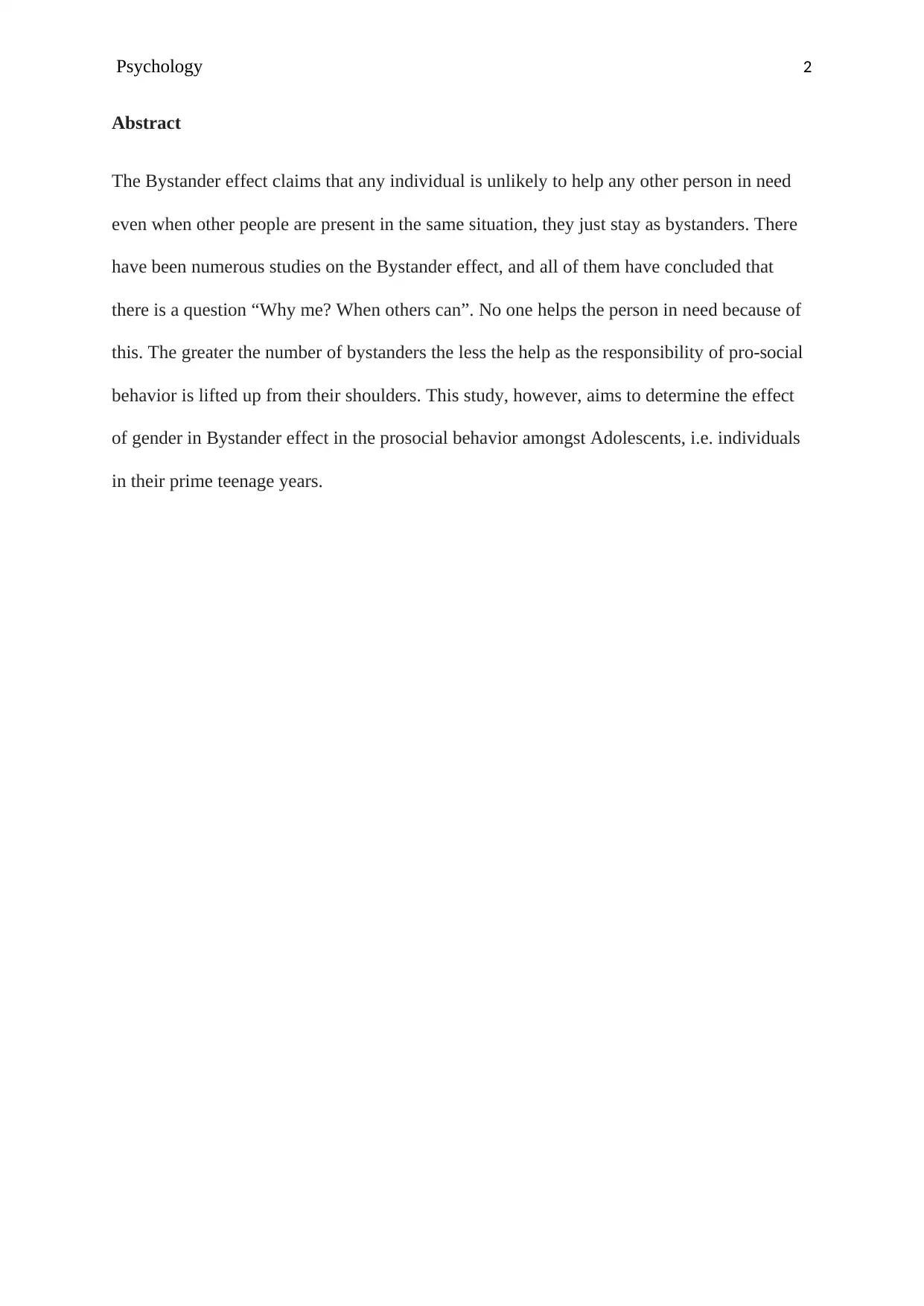
Psychology 2
Abstract
The Bystander effect claims that any individual is unlikely to help any other person in need
even when other people are present in the same situation, they just stay as bystanders. There
have been numerous studies on the Bystander effect, and all of them have concluded that
there is a question “Why me? When others can”. No one helps the person in need because of
this. The greater the number of bystanders the less the help as the responsibility of pro-social
behavior is lifted up from their shoulders. This study, however, aims to determine the effect
of gender in Bystander effect in the prosocial behavior amongst Adolescents, i.e. individuals
in their prime teenage years.
Abstract
The Bystander effect claims that any individual is unlikely to help any other person in need
even when other people are present in the same situation, they just stay as bystanders. There
have been numerous studies on the Bystander effect, and all of them have concluded that
there is a question “Why me? When others can”. No one helps the person in need because of
this. The greater the number of bystanders the less the help as the responsibility of pro-social
behavior is lifted up from their shoulders. This study, however, aims to determine the effect
of gender in Bystander effect in the prosocial behavior amongst Adolescents, i.e. individuals
in their prime teenage years.
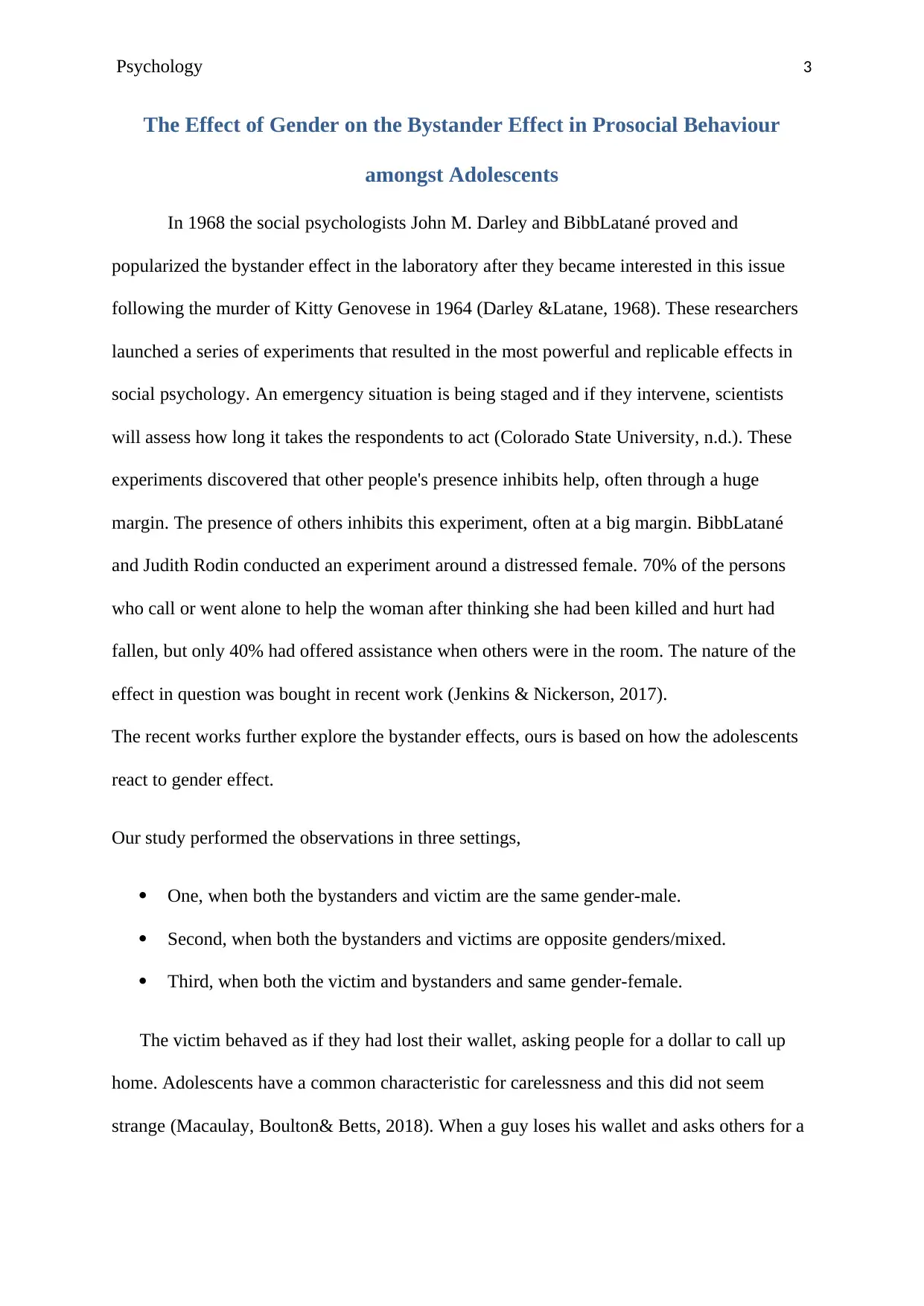
Psychology 3
The Effect of Gender on the Bystander Effect in Prosocial Behaviour
amongst Adolescents
In 1968 the social psychologists John M. Darley and BibbLatané proved and
popularized the bystander effect in the laboratory after they became interested in this issue
following the murder of Kitty Genovese in 1964 (Darley &Latane, 1968). These researchers
launched a series of experiments that resulted in the most powerful and replicable effects in
social psychology. An emergency situation is being staged and if they intervene, scientists
will assess how long it takes the respondents to act (Colorado State University, n.d.). These
experiments discovered that other people's presence inhibits help, often through a huge
margin. The presence of others inhibits this experiment, often at a big margin. BibbLatané
and Judith Rodin conducted an experiment around a distressed female. 70% of the persons
who call or went alone to help the woman after thinking she had been killed and hurt had
fallen, but only 40% had offered assistance when others were in the room. The nature of the
effect in question was bought in recent work (Jenkins & Nickerson, 2017).
The recent works further explore the bystander effects, ours is based on how the adolescents
react to gender effect.
Our study performed the observations in three settings,
One, when both the bystanders and victim are the same gender-male.
Second, when both the bystanders and victims are opposite genders/mixed.
Third, when both the victim and bystanders and same gender-female.
The victim behaved as if they had lost their wallet, asking people for a dollar to call up
home. Adolescents have a common characteristic for carelessness and this did not seem
strange (Macaulay, Boulton& Betts, 2018). When a guy loses his wallet and asks others for a
The Effect of Gender on the Bystander Effect in Prosocial Behaviour
amongst Adolescents
In 1968 the social psychologists John M. Darley and BibbLatané proved and
popularized the bystander effect in the laboratory after they became interested in this issue
following the murder of Kitty Genovese in 1964 (Darley &Latane, 1968). These researchers
launched a series of experiments that resulted in the most powerful and replicable effects in
social psychology. An emergency situation is being staged and if they intervene, scientists
will assess how long it takes the respondents to act (Colorado State University, n.d.). These
experiments discovered that other people's presence inhibits help, often through a huge
margin. The presence of others inhibits this experiment, often at a big margin. BibbLatané
and Judith Rodin conducted an experiment around a distressed female. 70% of the persons
who call or went alone to help the woman after thinking she had been killed and hurt had
fallen, but only 40% had offered assistance when others were in the room. The nature of the
effect in question was bought in recent work (Jenkins & Nickerson, 2017).
The recent works further explore the bystander effects, ours is based on how the adolescents
react to gender effect.
Our study performed the observations in three settings,
One, when both the bystanders and victim are the same gender-male.
Second, when both the bystanders and victims are opposite genders/mixed.
Third, when both the victim and bystanders and same gender-female.
The victim behaved as if they had lost their wallet, asking people for a dollar to call up
home. Adolescents have a common characteristic for carelessness and this did not seem
strange (Macaulay, Boulton& Betts, 2018). When a guy loses his wallet and asks others for a
⊘ This is a preview!⊘
Do you want full access?
Subscribe today to unlock all pages.

Trusted by 1+ million students worldwide
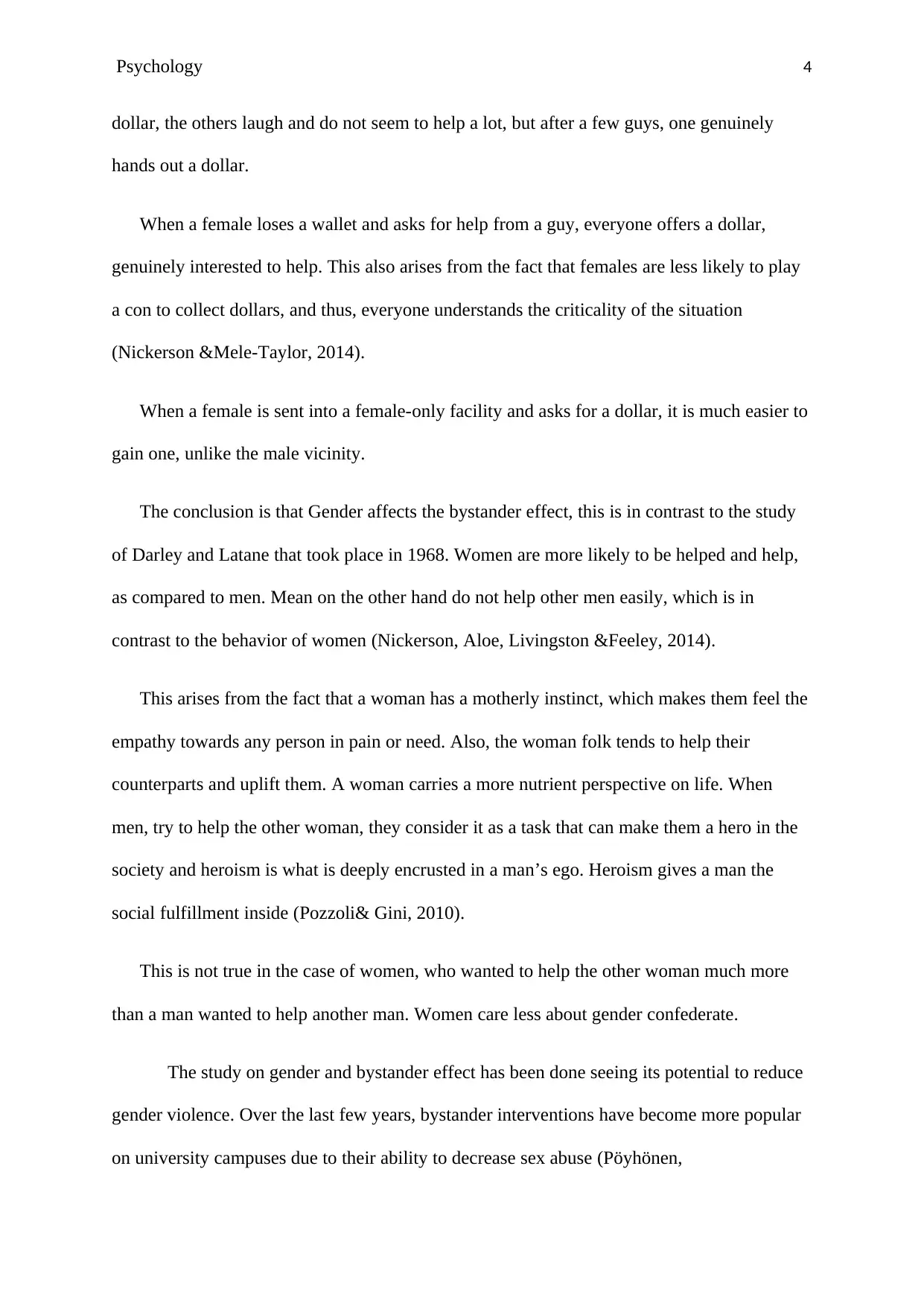
Psychology 4
dollar, the others laugh and do not seem to help a lot, but after a few guys, one genuinely
hands out a dollar.
When a female loses a wallet and asks for help from a guy, everyone offers a dollar,
genuinely interested to help. This also arises from the fact that females are less likely to play
a con to collect dollars, and thus, everyone understands the criticality of the situation
(Nickerson &Mele-Taylor, 2014).
When a female is sent into a female-only facility and asks for a dollar, it is much easier to
gain one, unlike the male vicinity.
The conclusion is that Gender affects the bystander effect, this is in contrast to the study
of Darley and Latane that took place in 1968. Women are more likely to be helped and help,
as compared to men. Mean on the other hand do not help other men easily, which is in
contrast to the behavior of women (Nickerson, Aloe, Livingston &Feeley, 2014).
This arises from the fact that a woman has a motherly instinct, which makes them feel the
empathy towards any person in pain or need. Also, the woman folk tends to help their
counterparts and uplift them. A woman carries a more nutrient perspective on life. When
men, try to help the other woman, they consider it as a task that can make them a hero in the
society and heroism is what is deeply encrusted in a man’s ego. Heroism gives a man the
social fulfillment inside (Pozzoli& Gini, 2010).
This is not true in the case of women, who wanted to help the other woman much more
than a man wanted to help another man. Women care less about gender confederate.
The study on gender and bystander effect has been done seeing its potential to reduce
gender violence. Over the last few years, bystander interventions have become more popular
on university campuses due to their ability to decrease sex abuse (Pöyhönen,
dollar, the others laugh and do not seem to help a lot, but after a few guys, one genuinely
hands out a dollar.
When a female loses a wallet and asks for help from a guy, everyone offers a dollar,
genuinely interested to help. This also arises from the fact that females are less likely to play
a con to collect dollars, and thus, everyone understands the criticality of the situation
(Nickerson &Mele-Taylor, 2014).
When a female is sent into a female-only facility and asks for a dollar, it is much easier to
gain one, unlike the male vicinity.
The conclusion is that Gender affects the bystander effect, this is in contrast to the study
of Darley and Latane that took place in 1968. Women are more likely to be helped and help,
as compared to men. Mean on the other hand do not help other men easily, which is in
contrast to the behavior of women (Nickerson, Aloe, Livingston &Feeley, 2014).
This arises from the fact that a woman has a motherly instinct, which makes them feel the
empathy towards any person in pain or need. Also, the woman folk tends to help their
counterparts and uplift them. A woman carries a more nutrient perspective on life. When
men, try to help the other woman, they consider it as a task that can make them a hero in the
society and heroism is what is deeply encrusted in a man’s ego. Heroism gives a man the
social fulfillment inside (Pozzoli& Gini, 2010).
This is not true in the case of women, who wanted to help the other woman much more
than a man wanted to help another man. Women care less about gender confederate.
The study on gender and bystander effect has been done seeing its potential to reduce
gender violence. Over the last few years, bystander interventions have become more popular
on university campuses due to their ability to decrease sex abuse (Pöyhönen,
Paraphrase This Document
Need a fresh take? Get an instant paraphrase of this document with our AI Paraphraser
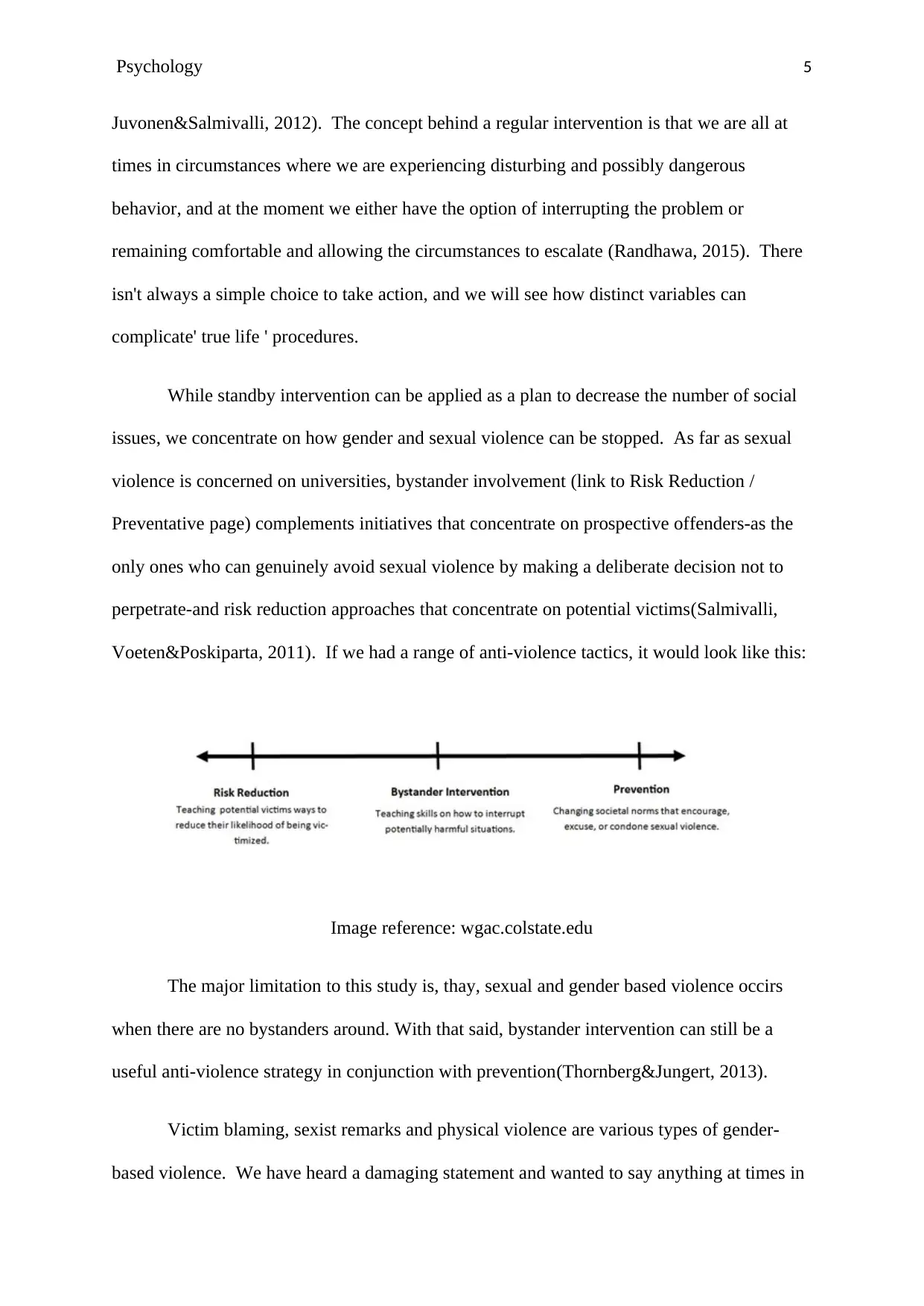
Psychology 5
Juvonen&Salmivalli, 2012). The concept behind a regular intervention is that we are all at
times in circumstances where we are experiencing disturbing and possibly dangerous
behavior, and at the moment we either have the option of interrupting the problem or
remaining comfortable and allowing the circumstances to escalate (Randhawa, 2015). There
isn't always a simple choice to take action, and we will see how distinct variables can
complicate' true life ' procedures.
While standby intervention can be applied as a plan to decrease the number of social
issues, we concentrate on how gender and sexual violence can be stopped. As far as sexual
violence is concerned on universities, bystander involvement (link to Risk Reduction /
Preventative page) complements initiatives that concentrate on prospective offenders-as the
only ones who can genuinely avoid sexual violence by making a deliberate decision not to
perpetrate-and risk reduction approaches that concentrate on potential victims(Salmivalli,
Voeten&Poskiparta, 2011). If we had a range of anti-violence tactics, it would look like this:
Image reference: wgac.colstate.edu
The major limitation to this study is, thay, sexual and gender based violence occirs
when there are no bystanders around. With that said, bystander intervention can still be a
useful anti-violence strategy in conjunction with prevention(Thornberg&Jungert, 2013).
Victim blaming, sexist remarks and physical violence are various types of gender-
based violence. We have heard a damaging statement and wanted to say anything at times in
Juvonen&Salmivalli, 2012). The concept behind a regular intervention is that we are all at
times in circumstances where we are experiencing disturbing and possibly dangerous
behavior, and at the moment we either have the option of interrupting the problem or
remaining comfortable and allowing the circumstances to escalate (Randhawa, 2015). There
isn't always a simple choice to take action, and we will see how distinct variables can
complicate' true life ' procedures.
While standby intervention can be applied as a plan to decrease the number of social
issues, we concentrate on how gender and sexual violence can be stopped. As far as sexual
violence is concerned on universities, bystander involvement (link to Risk Reduction /
Preventative page) complements initiatives that concentrate on prospective offenders-as the
only ones who can genuinely avoid sexual violence by making a deliberate decision not to
perpetrate-and risk reduction approaches that concentrate on potential victims(Salmivalli,
Voeten&Poskiparta, 2011). If we had a range of anti-violence tactics, it would look like this:
Image reference: wgac.colstate.edu
The major limitation to this study is, thay, sexual and gender based violence occirs
when there are no bystanders around. With that said, bystander intervention can still be a
useful anti-violence strategy in conjunction with prevention(Thornberg&Jungert, 2013).
Victim blaming, sexist remarks and physical violence are various types of gender-
based violence. We have heard a damaging statement and wanted to say anything at times in
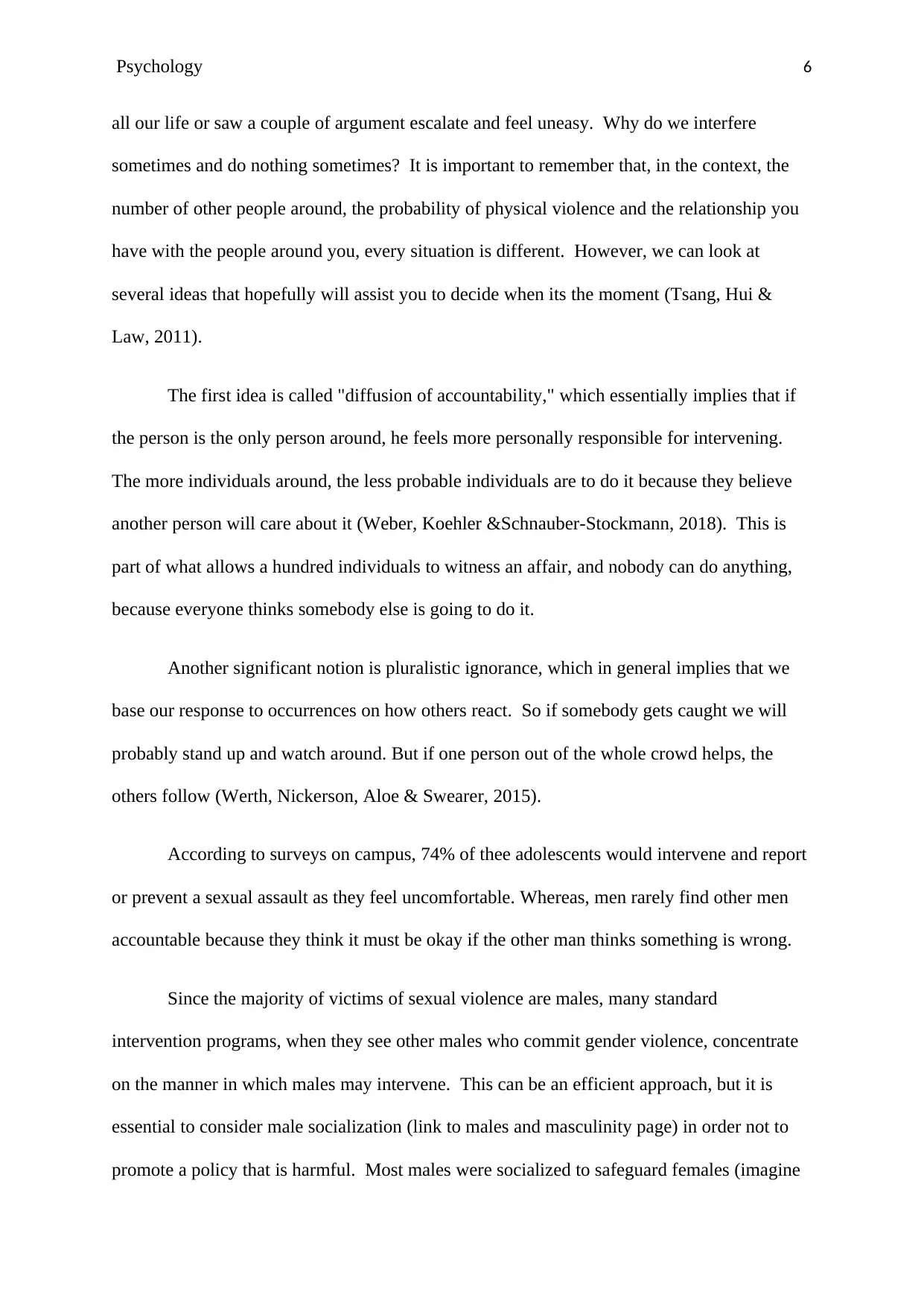
Psychology 6
all our life or saw a couple of argument escalate and feel uneasy. Why do we interfere
sometimes and do nothing sometimes? It is important to remember that, in the context, the
number of other people around, the probability of physical violence and the relationship you
have with the people around you, every situation is different. However, we can look at
several ideas that hopefully will assist you to decide when its the moment (Tsang, Hui &
Law, 2011).
The first idea is called "diffusion of accountability," which essentially implies that if
the person is the only person around, he feels more personally responsible for intervening.
The more individuals around, the less probable individuals are to do it because they believe
another person will care about it (Weber, Koehler &Schnauber-Stockmann, 2018). This is
part of what allows a hundred individuals to witness an affair, and nobody can do anything,
because everyone thinks somebody else is going to do it.
Another significant notion is pluralistic ignorance, which in general implies that we
base our response to occurrences on how others react. So if somebody gets caught we will
probably stand up and watch around. But if one person out of the whole crowd helps, the
others follow (Werth, Nickerson, Aloe & Swearer, 2015).
According to surveys on campus, 74% of thee adolescents would intervene and report
or prevent a sexual assault as they feel uncomfortable. Whereas, men rarely find other men
accountable because they think it must be okay if the other man thinks something is wrong.
Since the majority of victims of sexual violence are males, many standard
intervention programs, when they see other males who commit gender violence, concentrate
on the manner in which males may intervene. This can be an efficient approach, but it is
essential to consider male socialization (link to males and masculinity page) in order not to
promote a policy that is harmful. Most males were socialized to safeguard females (imagine
all our life or saw a couple of argument escalate and feel uneasy. Why do we interfere
sometimes and do nothing sometimes? It is important to remember that, in the context, the
number of other people around, the probability of physical violence and the relationship you
have with the people around you, every situation is different. However, we can look at
several ideas that hopefully will assist you to decide when its the moment (Tsang, Hui &
Law, 2011).
The first idea is called "diffusion of accountability," which essentially implies that if
the person is the only person around, he feels more personally responsible for intervening.
The more individuals around, the less probable individuals are to do it because they believe
another person will care about it (Weber, Koehler &Schnauber-Stockmann, 2018). This is
part of what allows a hundred individuals to witness an affair, and nobody can do anything,
because everyone thinks somebody else is going to do it.
Another significant notion is pluralistic ignorance, which in general implies that we
base our response to occurrences on how others react. So if somebody gets caught we will
probably stand up and watch around. But if one person out of the whole crowd helps, the
others follow (Werth, Nickerson, Aloe & Swearer, 2015).
According to surveys on campus, 74% of thee adolescents would intervene and report
or prevent a sexual assault as they feel uncomfortable. Whereas, men rarely find other men
accountable because they think it must be okay if the other man thinks something is wrong.
Since the majority of victims of sexual violence are males, many standard
intervention programs, when they see other males who commit gender violence, concentrate
on the manner in which males may intervene. This can be an efficient approach, but it is
essential to consider male socialization (link to males and masculinity page) in order not to
promote a policy that is harmful. Most males were socialized to safeguard females (imagine
⊘ This is a preview!⊘
Do you want full access?
Subscribe today to unlock all pages.

Trusted by 1+ million students worldwide
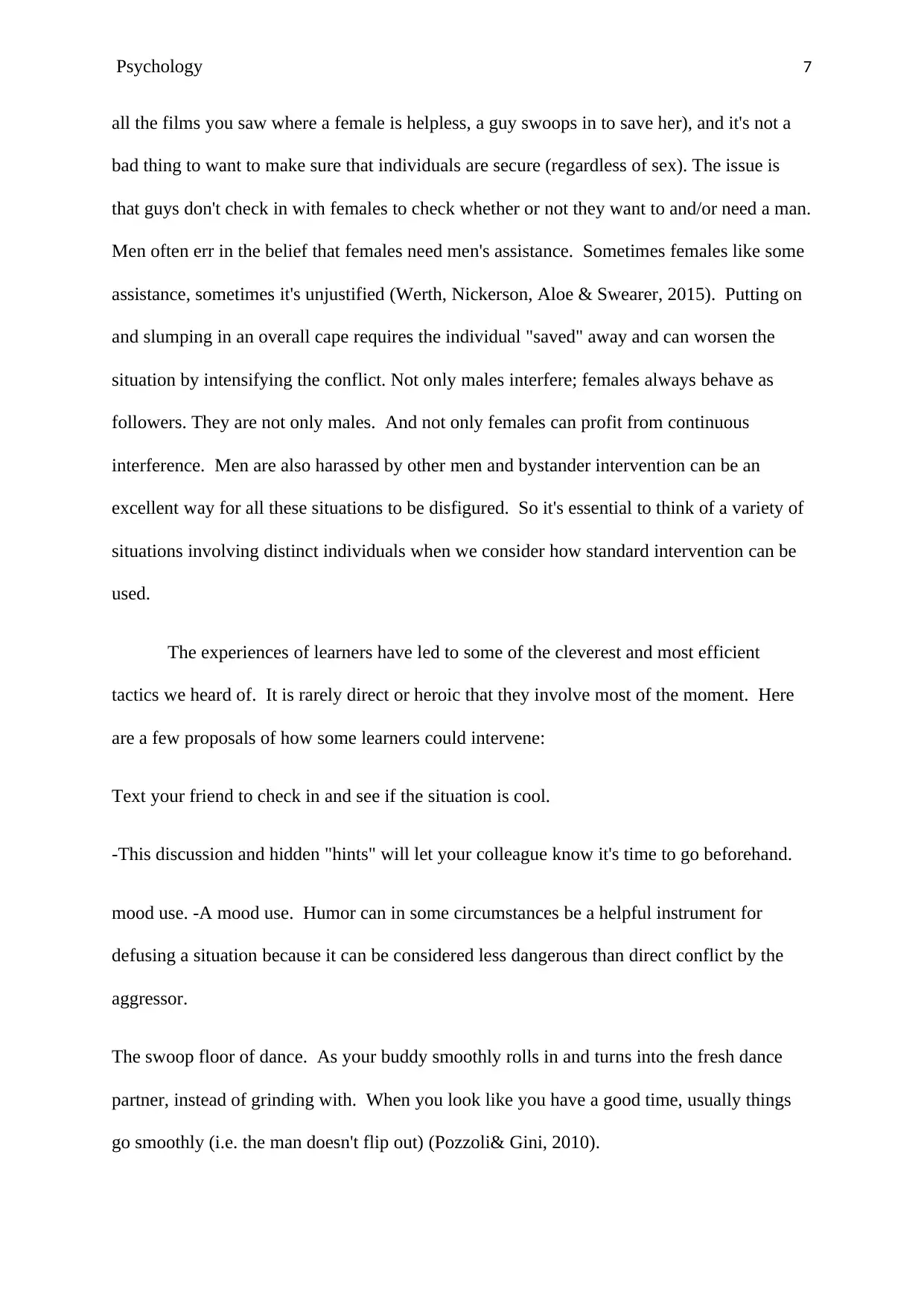
Psychology 7
all the films you saw where a female is helpless, a guy swoops in to save her), and it's not a
bad thing to want to make sure that individuals are secure (regardless of sex). The issue is
that guys don't check in with females to check whether or not they want to and/or need a man.
Men often err in the belief that females need men's assistance. Sometimes females like some
assistance, sometimes it's unjustified (Werth, Nickerson, Aloe & Swearer, 2015). Putting on
and slumping in an overall cape requires the individual "saved" away and can worsen the
situation by intensifying the conflict. Not only males interfere; females always behave as
followers. They are not only males. And not only females can profit from continuous
interference. Men are also harassed by other men and bystander intervention can be an
excellent way for all these situations to be disfigured. So it's essential to think of a variety of
situations involving distinct individuals when we consider how standard intervention can be
used.
The experiences of learners have led to some of the cleverest and most efficient
tactics we heard of. It is rarely direct or heroic that they involve most of the moment. Here
are a few proposals of how some learners could intervene:
Text your friend to check in and see if the situation is cool.
-This discussion and hidden "hints" will let your colleague know it's time to go beforehand.
mood use. -A mood use. Humor can in some circumstances be a helpful instrument for
defusing a situation because it can be considered less dangerous than direct conflict by the
aggressor.
The swoop floor of dance. As your buddy smoothly rolls in and turns into the fresh dance
partner, instead of grinding with. When you look like you have a good time, usually things
go smoothly (i.e. the man doesn't flip out) (Pozzoli& Gini, 2010).
all the films you saw where a female is helpless, a guy swoops in to save her), and it's not a
bad thing to want to make sure that individuals are secure (regardless of sex). The issue is
that guys don't check in with females to check whether or not they want to and/or need a man.
Men often err in the belief that females need men's assistance. Sometimes females like some
assistance, sometimes it's unjustified (Werth, Nickerson, Aloe & Swearer, 2015). Putting on
and slumping in an overall cape requires the individual "saved" away and can worsen the
situation by intensifying the conflict. Not only males interfere; females always behave as
followers. They are not only males. And not only females can profit from continuous
interference. Men are also harassed by other men and bystander intervention can be an
excellent way for all these situations to be disfigured. So it's essential to think of a variety of
situations involving distinct individuals when we consider how standard intervention can be
used.
The experiences of learners have led to some of the cleverest and most efficient
tactics we heard of. It is rarely direct or heroic that they involve most of the moment. Here
are a few proposals of how some learners could intervene:
Text your friend to check in and see if the situation is cool.
-This discussion and hidden "hints" will let your colleague know it's time to go beforehand.
mood use. -A mood use. Humor can in some circumstances be a helpful instrument for
defusing a situation because it can be considered less dangerous than direct conflict by the
aggressor.
The swoop floor of dance. As your buddy smoothly rolls in and turns into the fresh dance
partner, instead of grinding with. When you look like you have a good time, usually things
go smoothly (i.e. the man doesn't flip out) (Pozzoli& Gini, 2010).
Paraphrase This Document
Need a fresh take? Get an instant paraphrase of this document with our AI Paraphraser
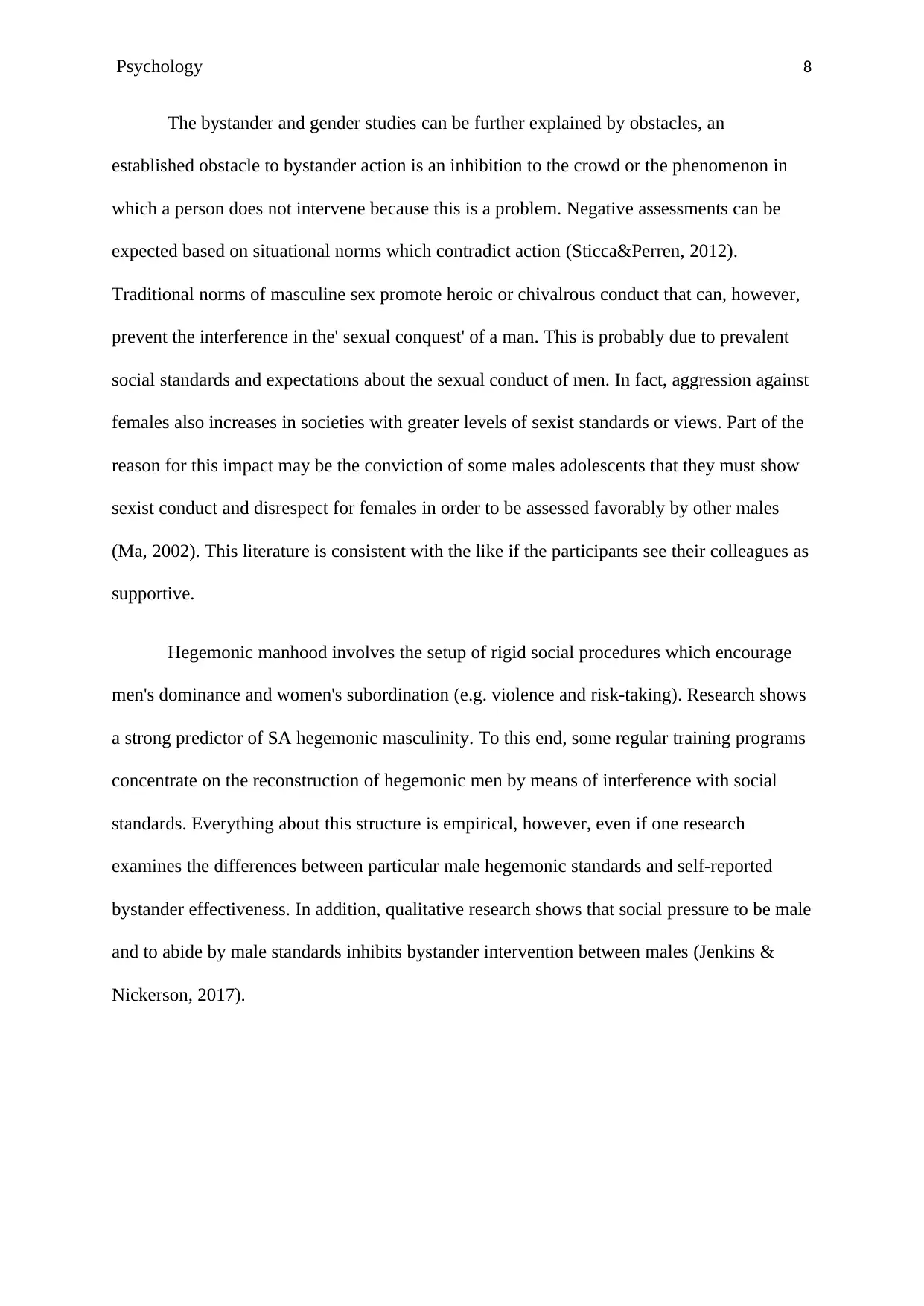
Psychology 8
The bystander and gender studies can be further explained by obstacles, an
established obstacle to bystander action is an inhibition to the crowd or the phenomenon in
which a person does not intervene because this is a problem. Negative assessments can be
expected based on situational norms which contradict action (Sticca&Perren, 2012).
Traditional norms of masculine sex promote heroic or chivalrous conduct that can, however,
prevent the interference in the' sexual conquest' of a man. This is probably due to prevalent
social standards and expectations about the sexual conduct of men. In fact, aggression against
females also increases in societies with greater levels of sexist standards or views. Part of the
reason for this impact may be the conviction of some males adolescents that they must show
sexist conduct and disrespect for females in order to be assessed favorably by other males
(Ma, 2002). This literature is consistent with the like if the participants see their colleagues as
supportive.
Hegemonic manhood involves the setup of rigid social procedures which encourage
men's dominance and women's subordination (e.g. violence and risk-taking). Research shows
a strong predictor of SA hegemonic masculinity. To this end, some regular training programs
concentrate on the reconstruction of hegemonic men by means of interference with social
standards. Everything about this structure is empirical, however, even if one research
examines the differences between particular male hegemonic standards and self-reported
bystander effectiveness. In addition, qualitative research shows that social pressure to be male
and to abide by male standards inhibits bystander intervention between males (Jenkins &
Nickerson, 2017).
The bystander and gender studies can be further explained by obstacles, an
established obstacle to bystander action is an inhibition to the crowd or the phenomenon in
which a person does not intervene because this is a problem. Negative assessments can be
expected based on situational norms which contradict action (Sticca&Perren, 2012).
Traditional norms of masculine sex promote heroic or chivalrous conduct that can, however,
prevent the interference in the' sexual conquest' of a man. This is probably due to prevalent
social standards and expectations about the sexual conduct of men. In fact, aggression against
females also increases in societies with greater levels of sexist standards or views. Part of the
reason for this impact may be the conviction of some males adolescents that they must show
sexist conduct and disrespect for females in order to be assessed favorably by other males
(Ma, 2002). This literature is consistent with the like if the participants see their colleagues as
supportive.
Hegemonic manhood involves the setup of rigid social procedures which encourage
men's dominance and women's subordination (e.g. violence and risk-taking). Research shows
a strong predictor of SA hegemonic masculinity. To this end, some regular training programs
concentrate on the reconstruction of hegemonic men by means of interference with social
standards. Everything about this structure is empirical, however, even if one research
examines the differences between particular male hegemonic standards and self-reported
bystander effectiveness. In addition, qualitative research shows that social pressure to be male
and to abide by male standards inhibits bystander intervention between males (Jenkins &
Nickerson, 2017).
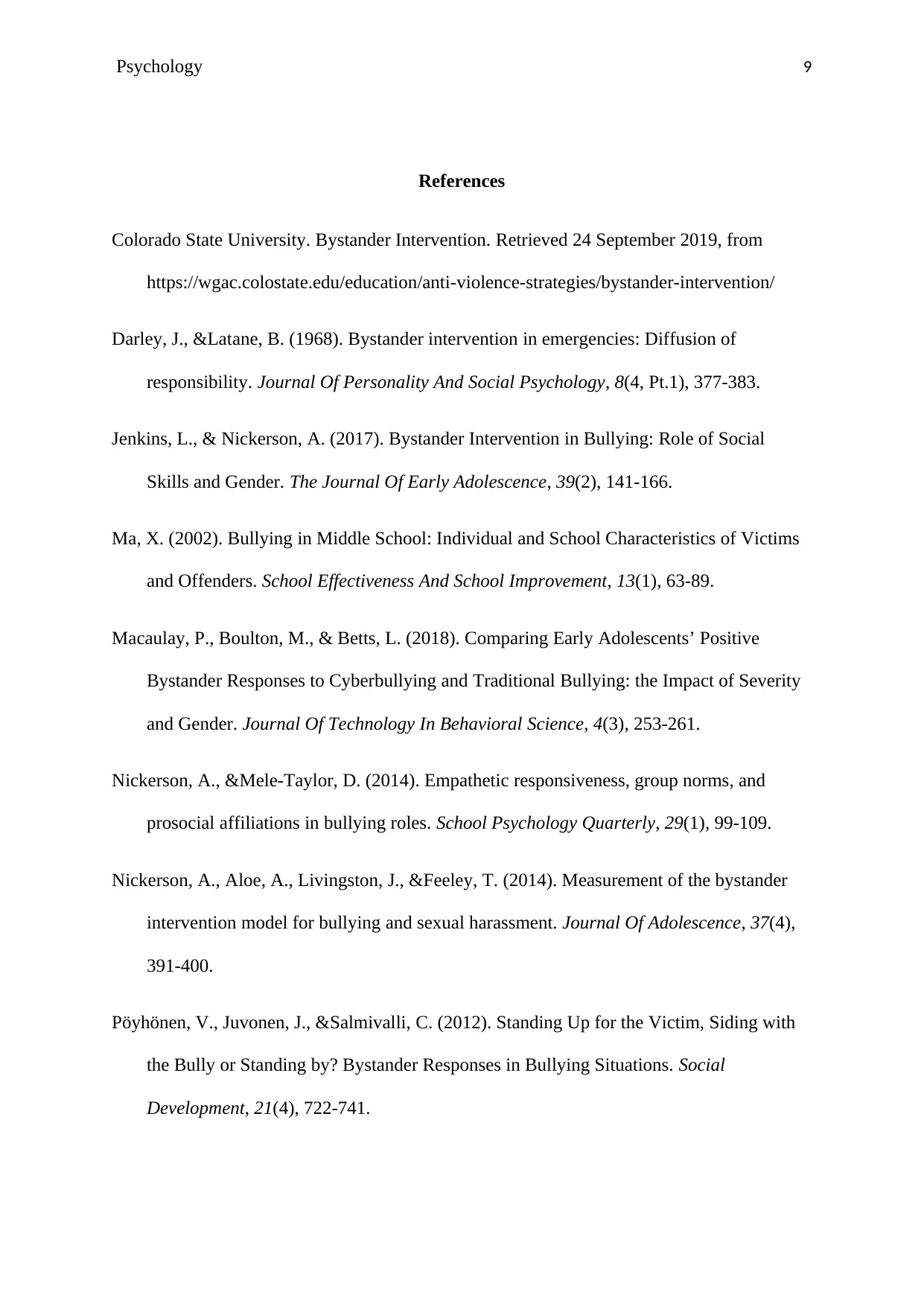
Psychology 9
References
Colorado State University. Bystander Intervention. Retrieved 24 September 2019, from
https://wgac.colostate.edu/education/anti-violence-strategies/bystander-intervention/
Darley, J., &Latane, B. (1968). Bystander intervention in emergencies: Diffusion of
responsibility. Journal Of Personality And Social Psychology, 8(4, Pt.1), 377-383.
Jenkins, L., & Nickerson, A. (2017). Bystander Intervention in Bullying: Role of Social
Skills and Gender. The Journal Of Early Adolescence, 39(2), 141-166.
Ma, X. (2002). Bullying in Middle School: Individual and School Characteristics of Victims
and Offenders. School Effectiveness And School Improvement, 13(1), 63-89.
Macaulay, P., Boulton, M., & Betts, L. (2018). Comparing Early Adolescents’ Positive
Bystander Responses to Cyberbullying and Traditional Bullying: the Impact of Severity
and Gender. Journal Of Technology In Behavioral Science, 4(3), 253-261.
Nickerson, A., &Mele-Taylor, D. (2014). Empathetic responsiveness, group norms, and
prosocial affiliations in bullying roles. School Psychology Quarterly, 29(1), 99-109.
Nickerson, A., Aloe, A., Livingston, J., &Feeley, T. (2014). Measurement of the bystander
intervention model for bullying and sexual harassment. Journal Of Adolescence, 37(4),
391-400.
Pöyhönen, V., Juvonen, J., &Salmivalli, C. (2012). Standing Up for the Victim, Siding with
the Bully or Standing by? Bystander Responses in Bullying Situations. Social
Development, 21(4), 722-741.
References
Colorado State University. Bystander Intervention. Retrieved 24 September 2019, from
https://wgac.colostate.edu/education/anti-violence-strategies/bystander-intervention/
Darley, J., &Latane, B. (1968). Bystander intervention in emergencies: Diffusion of
responsibility. Journal Of Personality And Social Psychology, 8(4, Pt.1), 377-383.
Jenkins, L., & Nickerson, A. (2017). Bystander Intervention in Bullying: Role of Social
Skills and Gender. The Journal Of Early Adolescence, 39(2), 141-166.
Ma, X. (2002). Bullying in Middle School: Individual and School Characteristics of Victims
and Offenders. School Effectiveness And School Improvement, 13(1), 63-89.
Macaulay, P., Boulton, M., & Betts, L. (2018). Comparing Early Adolescents’ Positive
Bystander Responses to Cyberbullying and Traditional Bullying: the Impact of Severity
and Gender. Journal Of Technology In Behavioral Science, 4(3), 253-261.
Nickerson, A., &Mele-Taylor, D. (2014). Empathetic responsiveness, group norms, and
prosocial affiliations in bullying roles. School Psychology Quarterly, 29(1), 99-109.
Nickerson, A., Aloe, A., Livingston, J., &Feeley, T. (2014). Measurement of the bystander
intervention model for bullying and sexual harassment. Journal Of Adolescence, 37(4),
391-400.
Pöyhönen, V., Juvonen, J., &Salmivalli, C. (2012). Standing Up for the Victim, Siding with
the Bully or Standing by? Bystander Responses in Bullying Situations. Social
Development, 21(4), 722-741.
⊘ This is a preview!⊘
Do you want full access?
Subscribe today to unlock all pages.

Trusted by 1+ million students worldwide
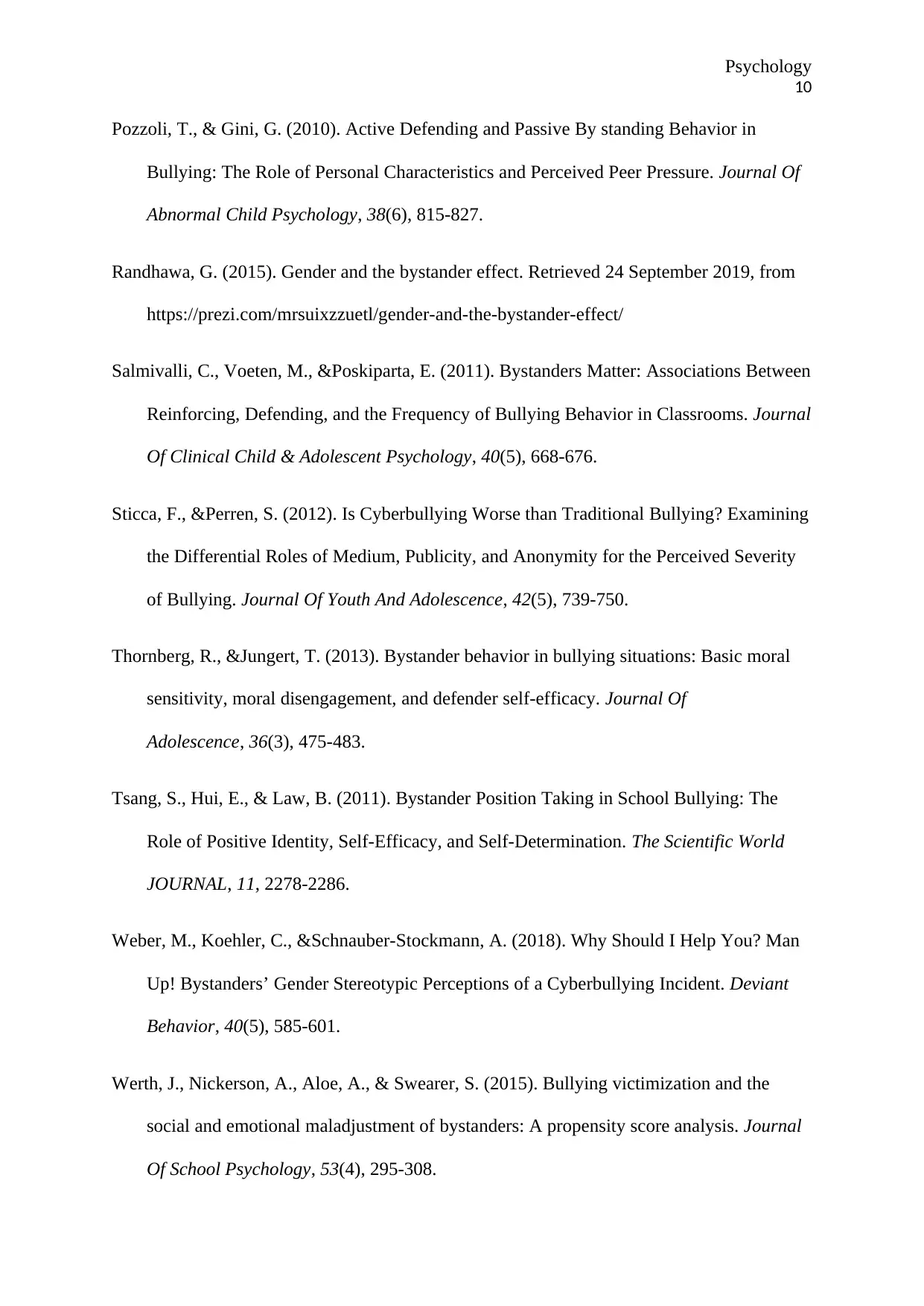
Psychology
10
Pozzoli, T., & Gini, G. (2010). Active Defending and Passive By standing Behavior in
Bullying: The Role of Personal Characteristics and Perceived Peer Pressure. Journal Of
Abnormal Child Psychology, 38(6), 815-827.
Randhawa, G. (2015). Gender and the bystander effect. Retrieved 24 September 2019, from
https://prezi.com/mrsuixzzuetl/gender-and-the-bystander-effect/
Salmivalli, C., Voeten, M., &Poskiparta, E. (2011). Bystanders Matter: Associations Between
Reinforcing, Defending, and the Frequency of Bullying Behavior in Classrooms. Journal
Of Clinical Child & Adolescent Psychology, 40(5), 668-676.
Sticca, F., &Perren, S. (2012). Is Cyberbullying Worse than Traditional Bullying? Examining
the Differential Roles of Medium, Publicity, and Anonymity for the Perceived Severity
of Bullying. Journal Of Youth And Adolescence, 42(5), 739-750.
Thornberg, R., &Jungert, T. (2013). Bystander behavior in bullying situations: Basic moral
sensitivity, moral disengagement, and defender self-efficacy. Journal Of
Adolescence, 36(3), 475-483.
Tsang, S., Hui, E., & Law, B. (2011). Bystander Position Taking in School Bullying: The
Role of Positive Identity, Self-Efficacy, and Self-Determination. The Scientific World
JOURNAL, 11, 2278-2286.
Weber, M., Koehler, C., &Schnauber-Stockmann, A. (2018). Why Should I Help You? Man
Up! Bystanders’ Gender Stereotypic Perceptions of a Cyberbullying Incident. Deviant
Behavior, 40(5), 585-601.
Werth, J., Nickerson, A., Aloe, A., & Swearer, S. (2015). Bullying victimization and the
social and emotional maladjustment of bystanders: A propensity score analysis. Journal
Of School Psychology, 53(4), 295-308.
10
Pozzoli, T., & Gini, G. (2010). Active Defending and Passive By standing Behavior in
Bullying: The Role of Personal Characteristics and Perceived Peer Pressure. Journal Of
Abnormal Child Psychology, 38(6), 815-827.
Randhawa, G. (2015). Gender and the bystander effect. Retrieved 24 September 2019, from
https://prezi.com/mrsuixzzuetl/gender-and-the-bystander-effect/
Salmivalli, C., Voeten, M., &Poskiparta, E. (2011). Bystanders Matter: Associations Between
Reinforcing, Defending, and the Frequency of Bullying Behavior in Classrooms. Journal
Of Clinical Child & Adolescent Psychology, 40(5), 668-676.
Sticca, F., &Perren, S. (2012). Is Cyberbullying Worse than Traditional Bullying? Examining
the Differential Roles of Medium, Publicity, and Anonymity for the Perceived Severity
of Bullying. Journal Of Youth And Adolescence, 42(5), 739-750.
Thornberg, R., &Jungert, T. (2013). Bystander behavior in bullying situations: Basic moral
sensitivity, moral disengagement, and defender self-efficacy. Journal Of
Adolescence, 36(3), 475-483.
Tsang, S., Hui, E., & Law, B. (2011). Bystander Position Taking in School Bullying: The
Role of Positive Identity, Self-Efficacy, and Self-Determination. The Scientific World
JOURNAL, 11, 2278-2286.
Weber, M., Koehler, C., &Schnauber-Stockmann, A. (2018). Why Should I Help You? Man
Up! Bystanders’ Gender Stereotypic Perceptions of a Cyberbullying Incident. Deviant
Behavior, 40(5), 585-601.
Werth, J., Nickerson, A., Aloe, A., & Swearer, S. (2015). Bullying victimization and the
social and emotional maladjustment of bystanders: A propensity score analysis. Journal
Of School Psychology, 53(4), 295-308.
Paraphrase This Document
Need a fresh take? Get an instant paraphrase of this document with our AI Paraphraser

Psychology
11
11
1 out of 11
Your All-in-One AI-Powered Toolkit for Academic Success.
+13062052269
info@desklib.com
Available 24*7 on WhatsApp / Email
![[object Object]](/_next/static/media/star-bottom.7253800d.svg)
Unlock your academic potential
Copyright © 2020–2025 A2Z Services. All Rights Reserved. Developed and managed by ZUCOL.